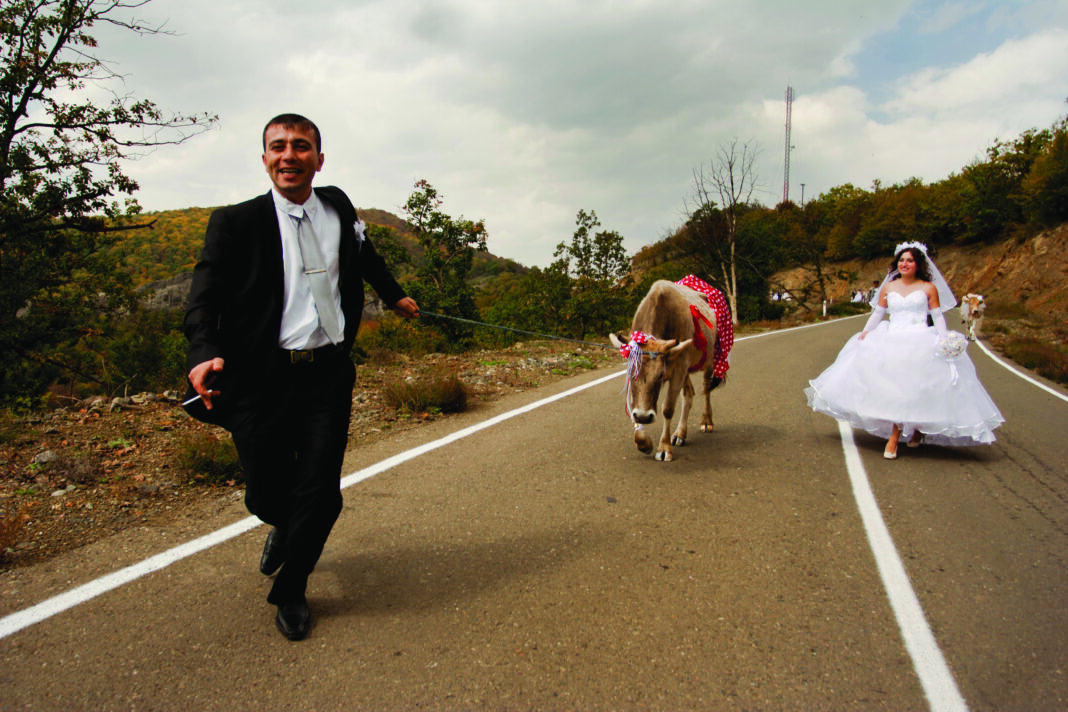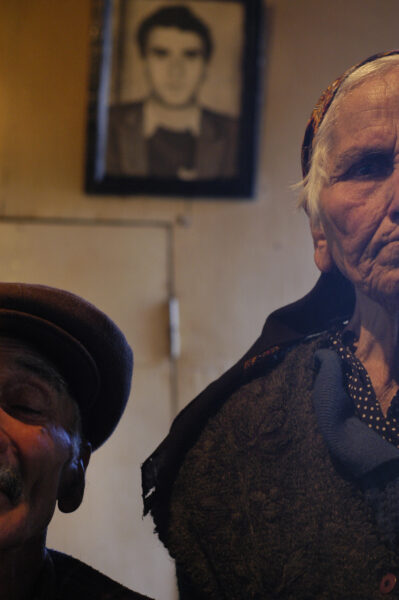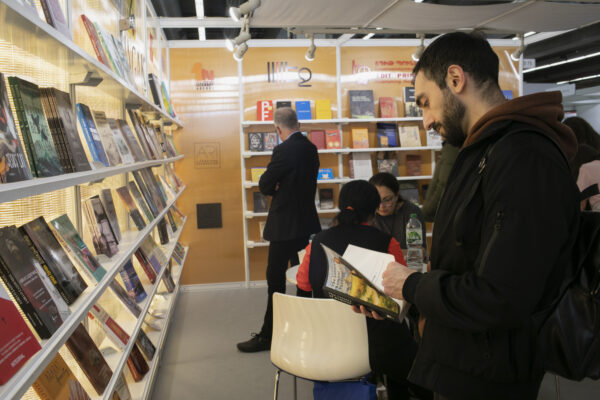
After the ceremony at Gandzasar Cathedral, one of about 700 couples who married on the same day in Artsakh. 2008
(Anahit Hayrapetyan photo)
Poetry in Word and Image: Anahit Hayrapetyan in Frankfurt
by Muriel Mirak-Weissbach
the Armenian Mirror Spectator
FRANKFURT , NOVEMBER 14, 2024 – The annual Frankfurt Book Fair represents a cultural highpoint in Germany, as authors, publishers, booksellers, literary agents, and booklovers from around the world gather to honor one country’s literary contributions, and explore the vast offering of new titles in every language culture. This year’s guest country was Italy, which presented its new selections under the rubric “Roots in the Future.”
As always, the Republic of Armenia is present with a stand to exhibit works by Armenian authors in the original, as well as numerous volumes as part of its ambitious “Armenian Literature in Translation” project. Armenian publishers and authors are eager to make their works known abroad. This year, the delegation from Yerevan organized an event dedicated to this pursuit: “Looking for a Place: Armenian Literature in Europe” was moderated by Jürgen Jacob Becker, deputy director of the Literary Colloquium in Berlin. Guests included writers Anush Kocharyan, Aram Pachyan and Sargis Hovsepyan, as well as Literary Critic Tigran Amiryan.
It has become traditional for cultural associations even outside the book fair to organize readings and performances in and around the city, among them, the Armenian Cultural Society in Hessen (AKV). This year the co-chairs of the board, Shushan Tumanyan and Armin Preuss, invited renowned photographer and writer Anahit Hayrapetyan, and myself to share the podium. I presented my work on German General Otto Liman von Sanders, an exceptional figure who contravened Young Turk deportation orders during the Ottoman genocide and saved thousands of Armenians and Greeks.
Anahit Hayrapetyan dealt with the suffering of Armenians in the present day, specifically in Artsakh. The selection of her photographs, projected on a screen, included portraits of individuals whose lives have been radically altered by the repeated wars and recent expulsion. There is the young man shaving, not at home in front of a well-lit mirror, but outdoors, in a soldier’s uniform, doing his best with a makeshift razor and small mirror balanced on a stone wall. There is the elderly couple, whose faces appear only in part, as if to symbolize that half of their own being has been taken away—that missing part we see between them, behind them, a photograph on the wall of the dead soldier. And in contrast, there is the joy of a young wedding pair, travelling in traditional means of transportation.…

The Shadyans before a portrait of his son, killed defending his homeland in the 1991-1994 Nagorno-Karabakh war. 2006 (Anahit Hayrapetyan photo)
The photographer has printed the pictures on postcards and published them in a collection entitled, “Բացիկներ Արցախից” (“Postcards from Artsakh”). Anahit Hayrapetyan, whose photos are highly poetical, composes poetry in words as well, and she read several of her compositions in Armenian from the collections, Վաղուց նամակ չեմ գրել (Haven’t Written a Letter in a Long Time) and Սիրուն (Pretty), with German translation provided by Shushan Tumanyan. One poem from the latter volume, entitled, “new war” evokes again the tragedy of Artsakh. It reads, in part:
new war
with all my power i hate wars
i hate war bitterness
hate the lament of mothers of lost sons
inner cries to gods
stretching to blue skies
through the velvet of smoke and oak tree my grandpa has put in my village
i hate gods with all my power
in my ears lives lament
of old women who lost their young sons in my eyes live images of social injustice and poverty
my fingernails are bitten to end
…
rockets thrown inside tear my face ears are crocked
with voice of dying old women rockets have torn the roads of wars my beautiful dreams stored
all i have
you
i am left alone all alone
totally alone
…
the rockets touch the starry sky
take me
carry me away
my love
(Translated by Tsovinar Chilingaryan)

The Armenian stand at the Frankfurt Book Fair
(Anahit Hayrapetyan photo)
A Visual Storyteller
Anahit Hayrapetyan studied at the Caucasus Institute in Yerevan and the State Engineering University of Armenia in 2005-2006. Following participation in World Press Photo Seminars in 2006, she decided to dedicate her efforts to a career in photojournalism. From 2009 to 2010, she studied photojournalism in Denmark followed by master classes organized by Noor-Nikon in Russia and Objective Reality.
Her work has been exhibited internationally, from Photoquai in France to Europe and Asia – Dialogue of Cultures in Russia, with group exhibitions in Istanbul, Yerevan, Gyumri, Mozambique, and beyond.
The Armenian artist, who is based in Frankfurt and travels frequently to Armenia, works with poetry and photography to explore themes of resilience, identity, and human rights. Through what she calls “visual storytelling,” she gives voice to the voiceless and provides a stage to the unrepresented. She is a co-founder of 4Plus, a collective for documentary photographers in Armenia.
Her photography has been published in prominent media outlets, including the New York Times Lens blog, EurasiaNet.org, Radio Free Europe, Hetq, Institute for War & Peace Reporting, Radio Free Europe, the New York Times, Le Point and IWPR.net, as well as National Geographic Traveler (Armenia), Armenianow.com, Gretert, and Enter (World Press Photo).

A soldier shaves near Talish, on the northern border of Nagorno-Karabakh. 2016 (Anahit Hayrapetyan photo)
She has been honored with several awards, among them the President of Armenia Award (2006), Asian Women Photographers’ Showcase (2013), and prizes at the Photovisa Festival (2008) and Karl Bulla International Photo Contest. Her poetry has appeared in four books thus far, Poems (2002), Taboo (2005), Pretty (2015) and Haven’t Written a Letter in a Long Time (2019). Her photobook, Princess to Slave, published by FotoEvidence in 2015, sheds light on domestic violence against women in Armenia. She tells the stories of five women, ranging from a local resident of the artist’s own village, to a woman who displayed the courage to take her case to court, thereby focusing public attention in Armenia on the plight of women victimized by domestic violence. The title of her work expresses the tragic irony of a culture that may idolize girls when children, treating them like princesses, but then allows them to be subjected to disrespect and abuse as adult women. The volume is introduced by Lara Aharonyan, director of the Women’s Resource Center of Armenia, who discusses the reasons why women have been deprived of liberty and equal opportunities in modern Armenia, and how women’s rights may be achieved.